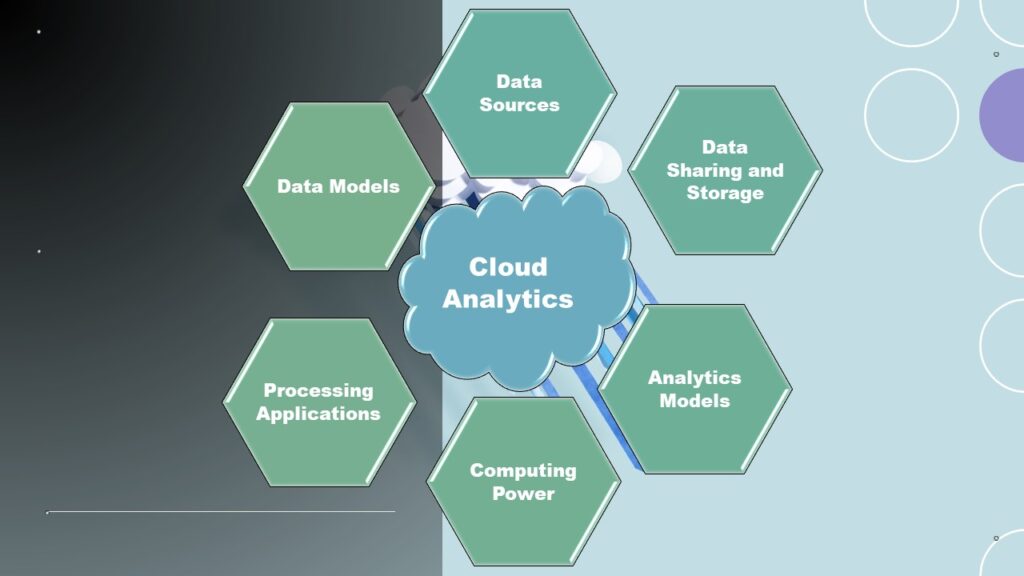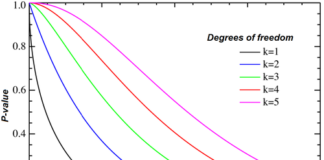In the modern digital economy, data has become the most valuable business asset. Every click, transaction, and customer interaction generates insights that can drive innovation, efficiency, and growth. However, with the explosion of big data, traditional on-premise analytics systems can no longer keep up with the scale and speed of modern information flows.
This challenge led to the evolution of cloud computing analytics, an approach that combines the scalability of cloud infrastructure with the intelligence of advanced data analytics.
Cloud analytics allows organizations to collect, process, and analyze massive datasets in real time, making data-driven decisions faster and more effectively than ever.
Understanding Cloud Computing Analytics
Cloud computing analytics refers to the process of performing data analytics using cloud infrastructure. Instead of relying on local servers or traditional data warehouses, businesses leverage cloud platforms like AWS, Google Cloud, or Microsoft Azure to store, process, and analyze large datasets.
Core Idea
At its core, cloud analytics provides:
- Scalability: Dynamically handle large data volumes.
- Accessibility: Access analytics tools and dashboards from anywhere.
- Cost-efficiency: Pay only for the resources you use.
- Integration: Combine diverse data sources seamlessly.
Cloud analytics merges cloud computing technologies (like distributed storage and virtualization) with data analytics models (like descriptive, predictive, and prescriptive analytics) to generate actionable business insights.
The Architecture of Cloud-Based Analytics Systems
A robust cloud analytics architecture typically includes the following components:

- Data Sources: CRM, ERP systems, IoT devices, APIs, and streaming data platforms.
- Data Ingestion Layer: Tools like Apache Kafka, AWS Kinesis, or Azure Data Factory move data into the cloud.
- Data Storage Layer: Data lakes and warehouses (e.g., Amazon Redshift, Google BigQuery, Snowflake).
- Processing Layer: Compute engines (e.g., Spark, Databricks) transform raw data.
- Analytics Layer: Machine learning models, BI tools, or visualization platforms analyze the data.
- Visualization Layer: Dashboards using Power BI, Tableau, or Looker for insight representation.
This architecture allows real-time analytics across structured, semi-structured, and unstructured data formats, supporting industries from healthcare to finance.
Key Components of Cloud Analytics
a. Data Warehousing
Stores large volumes of historical and current data for complex queries. Example: Google BigQuery.
b. Data Lakes
Handle raw and unprocessed data at scale. Example: Amazon S3 with AWS Glue.
c. ETL Pipelines
Extract, transform, and load (ETL) data for analysis using tools like Informatica or Talend.
d. Business Intelligence (BI) Tools
Convert analytics into decision-making dashboards. Example: Tableau and Power BI.
e. AI and Machine Learning Integration
Advanced analytics powered by AI models to predict trends and optimize operations.
How Cloud Computing Analytics Works
The process can be summarized in four major stages:
- Data Collection: Pull data from cloud-based and on-premise systems.
- Data Processing: Clean, filter, and prepare data using distributed systems.
- Data Analysis: Use statistical models and machine learning for insights.
- Data Visualization: Present data in interactive dashboards for business users.
For example, Netflix uses cloud analytics to predict what users will watch next, optimizing recommendations using behavioral data processed through AWS cloud infrastructure.
Benefits of Cloud-Based Data Analytics

a. Scalability
Cloud systems automatically scale based on workload without manual intervention.
b. Cost Efficiency
No upfront hardware cost — organizations pay for usage on-demand.
c. Real-Time Data Processing
Stream data and derive insights instantly using cloud-native tools like Google Dataflow.
d. Collaboration and Accessibility
Teams can collaborate globally using cloud-hosted analytics dashboards.
e. AI-Powered Insights
Cloud environments easily integrate with machine learning frameworks for predictive analytics.
f. Security and Compliance
Leading cloud providers offer encryption, access control, and compliance with standards like GDPR and HIPAA.
Cloud Analytics vs Traditional On-Premise Analytics
| Feature | Cloud Analytics | On-Premise Analytics |
| Scalability | Dynamic scaling | Limited capacity |
| Cost Model | Pay-as-you-go | High capital cost |
| Maintenance | Managed by provider | Managed by IT team |
| Data Access | Remote and global | Local network only |
| Updates | Automatic | Manual |
Cloud computing analytics wins by offering flexibility, agility, and faster innovation.
Real-World Use Cases of Cloud Analytics
1. Healthcare
Hospitals use cloud analytics to predict patient readmissions and manage medical records securely.
2. Finance
Banks use real-time fraud detection powered by Google Cloud AI and BigQuery.
3. Retail
Amazon and Walmart use analytics on AWS and Azure to optimize supply chains and personalize recommendations.
4. Manufacturing
IoT-driven analytics helps predict machine failures and optimize resource usage.
5. Smart Cities
Governments use cloud analytics platforms to monitor traffic patterns and energy consumption.
Major Platforms for Cloud Computing Analytics
- Amazon Web Services (AWS):
Offers Redshift, Kinesis, and SageMaker for analytics and AI. - Microsoft Azure:
Provides Synapse Analytics, Azure Data Factory, and Power BI. - Google Cloud Platform (GCP):
Known for BigQuery and AI Platform. - IBM Cloud:
Focuses on hybrid cloud analytics and AI-driven insights. - Snowflake:
A cloud-native data warehouse supporting multi-cloud analytics.
Cloud Analytics in AI and Machine Learning
AI-driven cloud analytics enhances predictive modeling, customer segmentation, and intelligent automation.
For example:
- Predictive Analytics: Forecast customer churn using ML models in the cloud.
- Sentiment Analysis: Use cloud-based NLP models to analyze social media data.
- Automated Decision-Making: Deploy ML pipelines on AWS SageMaker or Azure ML Studio.
AI integration empowers data-driven innovation by transforming raw data into real-time business actions.
Challenges and Security Concerns in Cloud Analytics
While cloud analytics offers immense potential, it also introduces certain challenges:
a. Data Security
Data hosted on third-party servers needs strict access control.
b. Compliance Issues
Organizations must follow data privacy laws across countries.
c. Integration Complexity
Integrating hybrid data sources requires robust data pipelines.
d. Vendor Lock-In
Switching between cloud providers can be costly.
e. Latency
Large-scale data transfers may cause processing delays.
Deep Dive into the Modern Cloud Analytics Architecture
Traditional three-tier architectures (data ingestion, storage, and analysis) are evolving into microservices-based, distributed ecosystems.
Modern cloud computing analytics systems now use containerization, serverless computing, and data mesh architectures to improve performance and reduce complexity.
a. Microservices and Containers
Microservices divide analytics workloads into small, reusable services—each focused on data collection, cleaning, or visualization.
These services are often deployed in containers using Docker or Kubernetes, ensuring scalability and fault tolerance.
b. Serverless Data Pipelines
Serverless platforms like AWS Lambda, Google Cloud Functions, and Azure Functions allow automatic execution of analytics jobs without managing servers.
For example:
- ETL tasks can be triggered automatically when data arrives.
- Real-time dashboards update without human intervention.
c. Data Mesh Approach
Instead of centralizing all data in one warehouse, data mesh distributes data ownership across domains (sales, marketing, HR).
Each domain manages its own data pipelines and analytics models, promoting agility and decentralization.
Cloud-Native Analytics Frameworks and Tools
Let’s look at some advanced frameworks that are redefining cloud analytics:
a. Apache Spark on Cloud
Apache Spark enables distributed data processing in-memory, reducing latency dramatically.
Cloud-native Spark platforms like Databricks, AWS Glue, and Google Dataproc optimize Spark clusters automatically for analytics workloads.
Example:
Spotify uses Databricks to analyze listener behavior across millions of users, generating real-time music recommendations.
b. Kubernetes-Based Data Orchestration
Tools like Airflow on Kubernetes or Prefect Cloud manage the scheduling of complex data workflows across clusters, enabling scalable analytics orchestration.
c. Delta Lake and Lakehouse Architecture
The Lakehouse model (popularized by Databricks) unifies data lakes and data warehouses, allowing both structured and unstructured data analytics on the same platform.
Key Benefit:
Businesses can run BI dashboards and ML workloads on the same data, reducing redundancy and improving consistency.
Advanced Security and Governance in Cloud Analytics
Data governance is becoming central to cloud analytics. With massive datasets crossing geographical and organizational boundaries, companies must balance innovation with compliance.
a. Data Encryption
Most major platforms (AWS, Azure, GCP) offer encryption at rest and in transit using AES-256 and TLS/SSL protocols.
b. Identity and Access Management (IAM)
Granular IAM roles control who can view, modify, or export analytics results, minimizing data breaches.
c. Zero-Trust Architecture
Zero-Trust frameworks in cloud analytics ensure that no user or device is inherently trusted, even within internal networks.
d. Compliance Automation
Platforms like AWS Audit Manager and Google Cloud DLP automate compliance reporting for standards like GDPR, HIPAA, and ISO 27001.
Real-Time and Streaming Analytics in the Cloud
With the rise of IoT and digital interactions, organizations require instant data insights. This has led to real-time cloud analytics systems capable of processing millions of data points per second.
a. Streaming Data Pipelines
Cloud platforms use tools like AWS Kinesis, Google Cloud Pub/Sub, or Apache Kafka for continuous data ingestion and transformation.
b. Real-Time Dashboards
BI tools such as Google Data Studio, Looker, and Tableau Online integrate with streaming platforms to visualize live metrics (e.g., sales, fraud detection, or sensor anomalies).
Example:
Uber uses a real-time analytics platform built on Apache Flink and Google BigQuery to track millions of rides per minute, optimizing routes and demand forecasting dynamically.
Integrating Cloud Analytics with Artificial Intelligence
The convergence of AI, ML, and cloud analytics marks a paradigm shift in how enterprises make decisions.
AI enables automated data pattern discovery, while the cloud provides unlimited computational scalability.
a. Machine Learning Pipelines
Cloud ML platforms—AWS SageMaker, Google Vertex AI, and Azure Machine Learning—allow data scientists to train, deploy, and monitor ML models directly within analytics workflows.
b. Generative AI for Cloud Analytics
Generative AI models such as ChatGPT, Google Gemini, or Anthropic Claude are now being integrated into analytics platforms to:
- Generate natural-language queries for analytics (e.g., “Show me last quarter’s sales trends in Europe”).
- Automate report generation and visualization.
- Suggest business insights from unstructured text or customer feedback.
Example:
Microsoft Fabric integrates generative AI into Power BI, allowing business users to interact conversationally with dashboards using Copilot for Analytics.
Hybrid and Multi-Cloud Analytics Strategies
In real-world enterprise environments, data often resides across multiple clouds or hybrid setups (cloud + on-premise).
Multi-cloud analytics provides flexibility, risk mitigation, and cost optimization.
a. Multi-Cloud Platforms
Solutions like Snowflake and Databricks Lakehouse support deployment across AWS, Azure, and Google Cloud simultaneously, giving enterprises freedom from vendor lock-in.
b. Data Federation
Federated query systems such as BigQuery Omni and Presto enable analytics across distributed datasets without moving them.
c. Edge-to-Cloud Integration
Edge computing complements cloud analytics by processing data locally (e.g., IoT devices, mobile sensors) before sending summarized insights to the cloud for large-scale analysis.
Example:
In autonomous vehicles, edge analytics performs local sensor data analysis, while aggregated driving data is sent to the cloud for performance optimization.
Performance Optimization and Cost Efficiency
Managing costs and performance in large-scale cloud analytics systems is a top priority.
a. Auto-Scaling and Resource Optimization
Modern cloud systems automatically adjust compute resources based on data load. For example, AWS Auto Scaling ensures efficient job execution without over-provisioning.
b. Query Optimization
Analytic engines like Google BigQuery and Amazon Redshift use intelligent caching and cost-based optimization to minimize execution time and storage costs.
c. Data Tiering
Storing cold data (infrequently accessed) in low-cost storage like AWS Glacier while keeping hot data in high-performance storage improves efficiency.
The Rise of Cloud-Native Data Observability
As analytics systems grow complex, data observability has emerged as a crucial discipline to ensure trust and reliability.
Data Observability Tools:
- Monte Carlo and Databand.ai detect data anomalies in real-time.
- Great Expectations automates data validation and quality monitoring.
This ensures analytics teams can detect errors early and maintain high data integrity.
Cloud Analytics and the Future of Predictive Business Intelligence
The future of analytics lies in self-service, predictive, and autonomous intelligence.
a. Predictive Business Analytics
Cloud AI models predict sales, churn, and demand patterns—empowering proactive decision-making.
b. Prescriptive Analytics
These systems don’t just analyze data but also recommend actions.
Example: An AI-driven supply chain system suggesting which distribution center should dispatch products based on real-time logistics data.
c. Augmented Analytics
Tools like Tableau GPT and Qlik Sense AI enable business users to query data conversationally and automatically generate reports without coding.
Emerging Trends Defining the Next Decade of Cloud Analytics
- Quantum Analytics — Using quantum computing for ultra-fast pattern discovery.
- Decentralized Cloud Data Ecosystems — Peer-to-peer analytics networks powered by blockchain.
- Ethical Cloud Analytics — Ensuring transparency, fairness, and privacy in algorithmic decision-making.
- Green Cloud Analytics — Energy-efficient cloud data centers reducing carbon footprints.
- Composable Analytics Platforms — Integrating modular components for flexible analytics pipelines.
Expert Insights: The Business Value of Cloud Analytics
According to Gartner’s 2024 report, over 80% of enterprise data analytics workloads will run in the cloud by 2027.
Companies using cloud-based analytics are experiencing:
- 2.5x faster decision-making
- 40% reduction in infrastructure costs
- 30% improved operational efficiency
Example:
Coca-Cola uses Google Cloud Analytics to monitor global supply chains and predict inventory needs in real-time—reducing operational costs and waste.
Future Trends and Innovations in Cloud Data Analytics
- Edge and Cloud Integration:
Combining edge computing with cloud analytics for low-latency insights. - Serverless Analytics:
Tools like AWS Lambda simplify data processing pipelines. - Quantum Cloud Analytics:
Emerging platforms will handle complex data problems exponentially faster. - AI-Augmented Analytics:
Automated insights and decision intelligence systems. - Sustainability-Driven Cloud Systems:
Green data centers and energy-efficient analytics architectures.
Conclusion: The Intelligent Future of Cloud Analytics
Cloud computing analytics has become the cornerstone of intelligent enterprises. It empowers organizations to scale operations, uncover deep insights, and make informed decisions — all in real-time.
As businesses continue to migrate to the cloud, analytics will no longer be an afterthought but the very foundation of innovation, efficiency, and strategic foresight.The integration of AI, ML, and edge computing will take analytics to new frontiers, helping companies turn data into intelligence and intelligence into action.
FAQ’s
What are the 4 pillars of data analytics?
The four pillars of data analytics are Descriptive, Diagnostic, Predictive, and Prescriptive analytics, each providing deeper insights — from understanding past trends to making data-driven decisions for the future.
What are the benefits of cloud analytics?
The benefits of cloud analytics include scalability, cost efficiency, real-time data access, enhanced collaboration, and advanced AI-powered insights, enabling organizations to make faster and smarter business decisions.
What are the 5 V’s of big data analytics?
The 5 V’s of Big Data Analytics are Volume, Velocity, Variety, Veracity, and Value, representing the size, speed, diversity, accuracy, and usefulness of data that drive meaningful business insights.
What are the 4 types of cloud computing models?
The four types of cloud computing models are Infrastructure as a Service (IaaS), Platform as a Service (PaaS), Software as a Service (SaaS), and Function as a Service (FaaS), each offering different levels of control and flexibility for users.
What are the 5 most common uses of cloud computing?
The five most common uses of cloud computing are data storage, web and application hosting, data analytics, disaster recovery, and software development and testing, all enabling flexibility and scalability for businesses.




